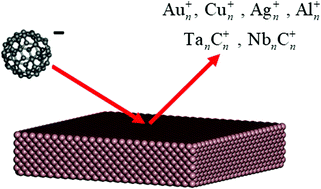Velocity correlated emission of secondary clusters by a single surface impact of a polyatomic ion: a new mechanism of cluster emission and subpicosecond probing of extreme spike conditions
Abstract
Emission of secondary clusters off clean solid surfaces following the impact of a projectile ion at kiloelectronvolt (keV) kinetic energies is important from both practical and fundamental points of view. Understanding the underlying emission mechanisms using different types and sizes of projectile ions is therefore of high interest. In this perspective article we provide an up-to-date review of our recently observed new mechanism of velocity correlated cluster emission (VCCE) describing the emission of large clusters off different targets following the impact of a large polyatomic ion (C60−). Due to its large collision cross section and large number of light constituent atoms, the incoming C60− disintegrates completely upon an impact resulting in a rather broad and shallow energy deposition, high subsurface energy density and ultrafast evolution of an extreme nonlinear collision cascade dynamics. It is shown that kinetic energy distributions (KEDs) of the emitted clusters behave very differently from the KEDs of cluster ions emitted following the impact of a heavy monoatomic ion. All the large clusters emitted from a given target (following the keV C60− impact) move with nearly the same velocity and their KEDs could be fairly well described by a shifted Maxwellian. Namely, a thermal distribution superimposed on a center-of-mass velocity of a moving precursor which is the source of the emitted clusters. So far we have measured and analyzed KEDs for NbnCn+, TanCn+,Agn+, Cun+, Aun+ and Aln+ clusters emitted from their respective metallic targets, thus demonstrating the general validity of the VCCE effect as a new sputtering mechanism. We have also proposed a simple model for the initial, subpicosecond emission step of the precursor (and the resulting emitted clusters) and supported it by molecular dynamics (MD) simulations of the thermal behavior of the impact induced spike on the subpicosecond timescale. It is shown that each complete family of measured cluster KEDs (for a given target) can serve as a unique diagnostic tool, probing the extreme temperature and pressure evolving in the impact induced spike. We will discuss our accumulated findings from new perspectives and report new observations and additional analysis aspects.

- This article is part of the themed collections: 2022 PCCP HOT Articles and PCCP Reviews


 Please wait while we load your content...
Please wait while we load your content...